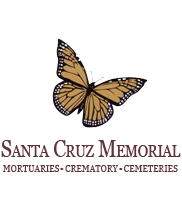A Walk Through Time at Santa Cruz Memorial Park
Take a Walk Through Time
The grounds of the cemetery at our Mission Chapel location are a perfect place to spend an afternoon delving into the history of our county. Many of the most famous and infamous people who shaped Santa Cruz are buried here, and some of the most devastating events in our history are chronicled through monuments both large and small.
The stories we’re about to share are taken from the booklet, A Walk through Time, available at no cost to you. If you find them engaging, and would like a copy, just complete the form below, or stop by our Mission Chapel office.
We invite you to take a stroll with us now, on a walk through time. You’ll be introduced to some of the most interesting people you could imagine, and we’re confident you’ll find inspiration in their stories.
• Georgiana Bruce Kirby
• Fred Swanton
• Mary McDermott
• Henry and Marion Meyrick
• Joseph Smallwood
• Frederick Hihn
We’ve also included stories, told through personal losses, of some of the events which changed lives here in Santa Cruz.
• The Diphtheria Epidemic of 1876
• The 1898 Powder Mill Explosion

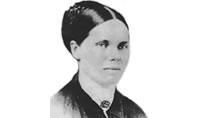 Georgiana Bruce Kirby
Georgiana Bruce Kirby
This was a woman ahead of her time. Born in Bristol, England, in 1818, Georgiana was an early advocate of women’s rights and civil liberties. Her intelligence and questioning mind would not allow her to accept a traditional life where she couldn’t pursue her own ambitions and goals.
This drive for achievement led her to come to North America as a teenager, where she became a school teacher. What better way to affect future generations?
She came under the influence of some of the most insightful men and women of her day, including Margaret Fuller, Nathaniel Hawthorne, and Ralph Waldo Emerson, when she joined the members of the elite Transcendentalist community outside of Boston, known as the Brook Farm Colony.
Transcendentalists were a group of people whose ideas developed in the 1830s and 1840s, as a protest against the general state of culture and society. Among their core beliefs was the conviction in an ideal spirituality that "transcends" the physical and is realized only through the individual's intuition, rather than through the doctrines of established religions. It was at Brook Farm that Georgiana’s intellectual strengths emerged, in the company of these ‘new age’ thinkers. To learn more about this spiritual movement in Santa Cruz, we refer you to the article archived on the website of the Santa Cruz Public Library, Santa Cruz Spirituality: Liberal, written by Paul Tutwiler.
It was 1850 when Georgiana migrated to the West Coast, and settled in Santa Cruz, where she founded the first Santa Cruz Society of Suffragists some nineteen years after her arrival. She was to marry a local tanner, Richard C. Kirby.
One of her friends from Brooke Farm, Eliza Farnham, was in Santa Cruz for a time, and together they made national headlines with their writings and their beliefs around topics including abolitionism, women’s suffrage, spiritualism, and the “science” of phrenology in the rehabilitation of prisoners. Both were extraordinarily gifted authors, and were at the vanguard of the major social and political movements of their time. Georgiana died on January 26th, 1887, at the age of sixty-nine.

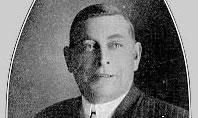 Fred Swanton
Fred Swanton
The foundation for the successful tourism industry in Santa Cruz was largely the work of this New York native. A true visionary, who possessed the unique ability to transform the environment around him to meet the desires of the greater population, Swanton was responsible for the first gas light system in the city, which later became the Santa Cruz Electric Light and Power Company; the Union Traction Company, which ran streetcars from Santa Cruz to Capitola; and he was instrumental in developing a phone system for the county in the 1880s.
But, what he’s always remembered for is the founding of the Seaside Company, which ultimately led to the county’s fame as a landmark destination for people all over the United States, and the world. He built the Neptune Casino and Pleasure Pier, which led to today’s Santa Cruz Beach Boardwalk. The history of this recreational landmark is fascinating in and of itself; we refer you to the article, Photographs of the Santa Cruz Beach Boardwalk Area: The 1904 Casino and Boardwalk, archived on the website of the Santa Cruz County Public Library system.
Swanton served as mayor of Santa Cruz in the 1920s and 1930s, and helped to bring the city to the silver screen by attracting the leading film directors of the era, and securing Santa Cruz as the backdrop for many early films. You can learn more about the history of film industry in Santa Cruz County from Ann Young’s article, Early Film Studios in Santa Cruz County, published on the Santa Cruz County Public Library System website.

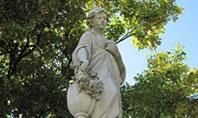 Henry and Marion Meyrick
Henry and Marion Meyrick
A mother’s treasure dead.
The staff on which my years should lean
Is broken ere those years come o’er me.
So reads the inscription on this beautiful monument, erected in memory of Marion and Henry Meyrick. Offering us a true love story tinged with tragedy, the tale of this young couple is quite memorable. In fact, it resonates closely with the story of Romeo and Juliet, the two literary lovers who died as a testament to their devotion.
Henry was the shy son of a prominent local businessman, while Marion was a fun-loving, high-spirited daughter of a neighbor. They were inseparable as children, and when Marion came of age, they were married.
It was just eight months later that Marion became gravely ill with an undiagnosed malady. She died in September of 1887, at the age of 20, leaving her husband alone with his grief.
Henry never recovered from the loss of the love of his life, and on February 8th, 1888, he went to her grave, put a small pistol to his heart, and pulled the trigger. He was buried by his beloved, to rest side-by-side, throughout time.
The memory of Marion Meyrick is also evident in the dedication of a beautiful stained glass window, found at the Cavalry Episcopal Church, in Santa Cruz. Located on the north side of the nave of the church, the window depicts St. Cecilia, the Patroness Saint of music, and was dedicated to Marion Armstrong Meyrick. You can view the monument on the grounds of Santa Cruz Memorial’s Mission Chapel, and then, when in downtown Santa Cruz, stop in to see this beautiful window in the Cavalry Episcopal Church, located at 532 Center Street. Visit their website for details and directions.

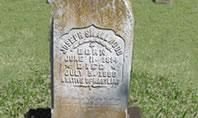 Joseph Smallwood
Joseph Smallwood
“Joe,” as he was known to the community, was an African-American pioneer of the county, and was very instrumental in leading the civil rights movement in the days before the Civil War, and Lincoln’s Emancipation Proclamation.
A barber by trade, Joseph Smallwood was born in Maryland in 1814, to parents who were ex-slaves, having been granted their freedom when England banned slavery on the island of Jamaica. After he married and moved his new family to Philadelphia, he set up his barber shop in the North Mulberry District of the city.
But, he didn’t stay long. When gold was discovered at Sutter’s Mill, he signed up as a ship steward aboard a vessel bound for California. He arrived in San Francisco in the summer of 1849, and immediately left for the goldfields. He remained in Coloma, in El Dorado County, until leaving for San Francisco in 1863. Just five years later, he headed on down the coast to Santa Cruz, where he became the leader of the local black community until he died in 1880.
Those 12 years in Santa Cruz were active ones for him. He helped to secure voting rights and other civil liberties for African-American citizens; served as a delegate to all the Colored People’s Conventions, and was a frequent contributor to the African-American press on the west coast. He led the fight to integrate public schools, and sponsored several young people who went on to attend the University of California at Berkeley.
Read To Know My Name: A Chronological History of African Americans in Santa Cruz County, by Phil Reader, archived on the Santa Cruz Public Library System website, to learn more about the African-Americans in the county.

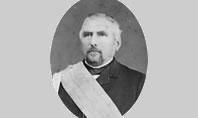 Frederick Hihn
Frederick Hihn
For more than 60 years, Frederick A. Hihn dominated the commercial, political, and social life of Santa Cruz County. In fact, the community we know today still reverberates with his influences. Frederick is a fine example of that immigrant who, upon their arrival in their new country, seizes opportunities at every turn.
Leaving Germany in 1829, he found himself a part of the influx of humanity into the California gold fields. While he experienced some success as a prospector, his real métier was in commerce. Beginning in San Francisco, later Sacramento, and finally Santa Cruz, Frederick prospered as a merchant.
His entrepreneurial skills led him into lumber, mining, railroads and land speculation. In fact, he was this county’s first millionaire, and a benevolent philanthropist. He served the community in many ways, ranging from school trustee to state assemblyman; but his countless charities endeared him to the people living here. Twice a year, on Christmas and Easter, the Hihn family opened their doors to the children of Santa Cruz, showering them generously with gifts.
You can read more about his commercial successes, and social impact on a number of websites, including the National Museum of American History, and the article, The Leftmost City: Power & Progressive Politics, found on the website of USCS Sociology Professor, William Domhoff, Who Rules America?
The important place Frederick held in the community was plainly evident when he died on August 24th, 1913, for thousands of local citizens joined his funeral cortege to pay their respects.

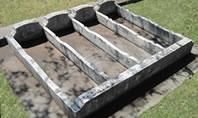 The Diphtheria Epidemic of 1876
The Diphtheria Epidemic of 1876
Oh, sweet be thy sleep in the land of the dead;
For our dear little angel we sorrow.
The spring shall return to thy low, narrow bed,
Like the beam of the day-star tomorrow.
~For Addie Mehwalt, aged 2 years, 7 months
History records that a sweeping outbreak of Diphtheria occurred throughout California during the two year period between the summers of 1876 and 1878. A disease primarily affecting young people, the illness took the lives of countless children, ranging in age from infancy to those in their early teens, throughout the county.
According to Phil Reader, in his work, Voices of the Heart: Memorial Poems from the Diphtheria Epidemic of 1876-1878, “during the two years of the plague there was at least one hundred and seventy-five known fatalities as a result of Diphtheria. Because there were so many deaths and funerals in such a relatively short period of time, and because the mourning was almost constant, a vast number of families chose to bury their youngsters without the usual amount of ceremony and public notice. These facts make it obvious that the true mortality figures for this epidemic will never be known.”
It was common for families to write a memorial poem for publication, amended to the death notice, in local newspapers. In fact, the opening stanza to this entry comes from one such notice, written by Alex and Mary Mehwalt, a young Santa Cruz couple who lost their daughter to the illness, and ended up leaving the area to assuage their grief.
Another family devastated by loss was that of the Hinds, who owned a small stationary and music store on Front Street. They lost four children, ranging in age from five years to eight months. The first died on Thanksgiving day, 1876, and the last child died on Christmas that year. They are buried, side-by-side, on the grounds of Santa Cruz Memorial Park.
To come to more deeply know the emotional devastation left in the wake of this epidemic, we invite you to read Phil Readers work, Voices of the Heart: Memorial Poems from the Diphtheria Epidemic of 18-76-1878, archived on the Santa Cruz Public Library website.

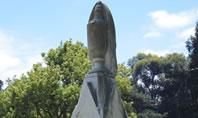 The 1898 Powder Mill Explosion
The 1898 Powder Mill Explosion
On the southern end of the cemetery, you’ll see a towering marble pedestal upon which rests a large urn, draped with a long, flowing, delicately hand carved mourning cloth. This is a classically beautiful presentation, erected in memory of the thirteen young men who lost their lives in a tragic accident at the California Powder Works, on April 26th, 1898.
An article published in the New York Times the following day described the incident for east coast readers.
Santa Cruz, Cal., April 26.-Three explosions about 5:15 this afternoon at the California Powder Works caused a greater loss of life than any previous accidents in the history of these works. The wildest rumors are prevalent regarding the number of killed and injured, the exact number of which cannot be ascertained before morning.
The first heavy shock from the explosion was felt for many miles around, and was separately followed by two lighter shocks. The smoke from the works arose in such dense volumes that it will be impossible for a time to perceive the extent of the damage that had been caused by the explosion. It was said that the fire was spreading and the main magazine was in imminent danger. The bugle call was accordingly sounded for members of the California Naval Reserve, who responded promptly, hurrying to the mills and assisting the corps of fire fighter already on the grounds.
As nearly as can be learned the primary cause of the disaster was the explosion of the cotton plant. The igniting of this plant caused the fire to spread to the adjoining brush and small building, and was them communicated to the powder mill flat, where are located the houses of the employees of the works. The employees and Naval Reserve boys worked heroically to prevent the fire from spreading to the smokeless powder plant.
The scarcity of water in the creek retarded the work of the volunteer fire brigade. Shovels and other tools were used instead of water fighting the flames.
The California Powder Works were located on the present site of Paradise Park. According to the New York Times article, “the works were established in 1861 on the present site, about two miles to the north of Santa Cruz, on the line of the Southern Pacific Coast Railroad. They comprise twenty-one powder mills, three shops, six magazines and stores, and thirty-five other buildings, situated upon the banks of the San Lorenzo, and stretching along the river for a mile.”
The city went into shock and mourning and the dead and injured flooded into area hospitals and mortuaries. It can be said that most families were personally touched by this tragedy, and the community came together to arrange a series of benefits to erect a fitting monument to the men who died that day.

Resources
Phil Reader, Voices of the Heart: Memorial Poems from the Diphtheria Epidemic of 1876-78, Cliffside Publishing, Santa Cruz, California, 1993.
A Walk Through Time: A Historical Guide to Santa Cruz Memorial Park, I.O.O.F. Lodge No. 96, 2004.
The New York Times article can be found reprinted on the GenDisasters website: http://www3.gendisasters.com/california/12531/santa-cruz-ca-powder-mills-explosion-apr-1898


